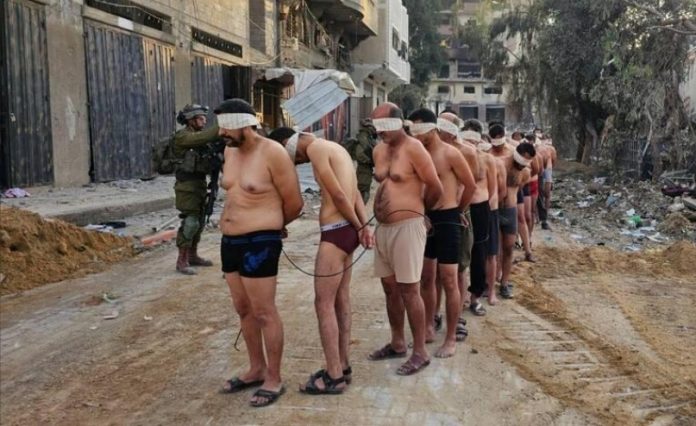The Hebrew word “hasbara” roughly translates to “explanation”. Hasbara shares much in common with other forms of modern propaganda, but analysts consider it a description of the more granular, event-by-event distortions and fabrications utilised by the Israeli government to justify its controversial actions and policies.

By Syed Khalid Husain,
South-east Asia Correspondent
Singapore: A video and pictures circulating in Israeli media claim the surrender of some Hamas fighters in the Jabalia city of Gaza. The images show half-naked people with their eyes covered and hands tied before being taken for questioning. But the Palestinian resistance group has rubbished the claim as “false and baseless”, and asserted the people seen in the pictures “were defenceless civilians after they were detained and weapons were placed next to them”.
Some critics have also cast doubt on the authenticity of the Israeli army’s video and said it was likely staged. Several Israeli observers and journalists have mocked their own army and accused it of lying by fabricating pictures and videos showing alleged members of the Izz ad-Din al-Qassam Brigades’ Elite Forces surrendering. Most highlighted that many of those shown in the pictures were elderly men and not young fighters who would normally make Elite Forces.
Israeli Prime Minister Benjamin Netanyahu also claimed this week dozens of Hamas militants have surrendered in recent days. Israeli war minister Yoav Gallant, meanwhile, claimed many of the Hamas militants surrendering were involved in the October 7 attack on the Zionist entity.
Israel has made several such claims about Hamas as well as its own conduct in the war since it began its barbaric air strikes on Gaza in response to the Palestinian movement’s October 7 surprise raid. It has continually accused Hamas of using schools, hospitals, neighbourhoods and factories as military areas and Palestinian civilians as “human shields”. But discerning the veracity of these claims has been difficult, mainly because the Israeli government uses a propaganda tool known as “hasbara” to control, shape and distort the narrative of every aspect of its actions.
The Hebrew word “hasbara” roughly translates to “explanation”. Hasbara shares much in common with other forms of modern propaganda, but analysts consider it a description of the more granular, event-by-event distortions and fabrications utilised by the Israeli government to justify its controversial actions and policies.
Hasbara is a public diplomacy technique which links information warfare with the strategic objectives of the Zionist entity. Public diplomacy is to be strategically conceived as a foreign policy priority, whereby a positive image of Israel is cultivated on the world stage, especially considering the image challenges Israel has continuously faced since its creation in 1948, according to Türkiye’s TRT World TV channel.
Promoting selective listening
While rooted in earlier concepts of agitprop and censorship, hasbara does not look to jam the supply of contradictory information to audiences; instead, it willingly accepts an open marketplace of opinion. What it seeks to do in this context is to promote selective listening by limiting the receptivity of audiences to information, rather than constricting its flow.
Israel even offers hasbara fellowships, scholarships and grants to foster pro-Israeli advocacy, while a number of individuals from journalists to bloggers work to spin a positive image of the Zionist entity.
To accomplish its mission, hasbara targets diplomats, politicians and the public through mass media. It is also accomplished through numerous institutes and government agencies, as well as in research centres, universities, non-governmental organisations and lobbying firms. Under the guise of neutrality, media discourse has been to describe the frequent conflict flaring up in occupied East Jerusalem as “clashes” between “both sides”.
Israel has long relied on a public diplomacy strategy to dominate the arena of narrative control and information manipulation. It is deeply aware that perception shapes reality. While it commits war crimes with impunity, it can do so only if there is a powerful enough propaganda machine it can deploy to counter its inevitable public condemnation and international solidarity with the Palestinians. And “hasbara” plays a crucial role in this effort.
Israelis are without doubt the most skilled contemporary practitioners of the art of deception. As Israel conducts its latest round of aggression against the Palestinians in Gaza Strip, the prevailing narrative often peddled in mainstream western media outlets continues to be implicitly framed to favour the Israeli narrative.
Israel’s ruthless bombardment of Gaza leading to the deaths of thousands of civilians is rationalised as an act of “self-defence” in response to Hamas’ rocket attacks on October 7 and its “use of human shields”.
One of the functions of hasbara is to justify the targeting of civilian areas and the consequent civilian deaths, as well as to shift blame for large numbers of civilian deaths from Israel to Hamas. This is one reason why Israel continually accuses Hamas of using schools, hospitals, neighbourhoods and factories as military areas and of using Palestinian civilians as so-called “human shields”.
Evacuation decried
In the current attack on Gaza, Israel has taken the “human shields” justification one step further. By issuing mass evacuation orders for every resident of northern Gaza, Israel’s hasbara narrative would have you believe it is trying to prevent human shields and civilian deaths.
However, some analysts have argued that issuing such an unrealistic and unworkable mass evacuation order has given Israel the green light to attack civilians, as it can whitewash such attacks by saying it warned civilians to flee. This, according to analysts, is why Israel’s attack on civilian areas has been so ferocious.
In late November, the Zionist military seized the Al Shifa Hospital in the Gaza Strip based on the above allegations, and observers are now calling for external independent verification to check on the claims. They say Israel must prove its claims that Hamas is housing an underground command centre beneath the territory’s biggest hospital.
Allan Behm, director of the International and Security Affairs Program at Australia Institute, told Singapore’s CNA news channel that there are many unknowns over Israel’s claims that it has discovered a tunnel and weapons under Al Shifa Hospital. A team led by the World Health Organization that visited the site described it as a “death zone”.
“If that hospital is essentially the command centre, at least underground, for Hamas, you might have expected Israel to be using this for all its worth,” said Mr Behm. He said the evidence backing up Israel’s action is not strong currently, and there will have to be greater “independent verification” on the matter.
Hasbara 2.0
Following the 2006 Lebanon war and “Operation Cast Lead” two years later, both of which seriously damaged Israel’s international reputation, there was a gradual shift between 2008 to 2012 to what Dutch anthropologist Miriyam Aouragh called “Hasbara 2.0”: an assertive digital diplomacy that accounted for web 2.0 technologies such as social media and YouTube.

Soon, hasbara-styled initiatives from the Israeli armed forces were being synchronised into a new online branch, with a permanent team operating in liaison with the Ministry of Strategic Affairs in 2008, according to TRT World. In 2012, Israel announced its war against Gaza on Twitter. During “Operation Pillar of Defense”, as Israeli-funnelled talking points saturated the US and European media landscape, hasbara made heavy use of the more distilled communication channels of social media. It further exploited browser functions, search engine algorithms, and other automated mechanisms that controlled what content was presented to viewers.
In the process, Israel designed a narrative of itself as the innocent victim of Palestinian “terrorism”, one that was accorded with the sovereign right of defence against existential assault. This, despite the fact of having initiated the escalation, possessing advanced aerial power against an adversary without one, and unloading more than a thousand times as many tons of munitions on Gazans.
In 2014, Israel’s war in Gaza under “Operation Protective Edge” prompted a much greater pushback to its media narrative, clearly underestimating the extent of the global outrage to their actions in Gaza. As images of destruction and dismembered bodies of innocent civilians flooded social media, hasbara proponents were forced to re-double their efforts in well-orchestrated PR campaigns that attempted to reframe war crimes with talking points to whitewash any disproportionate use of force – which even ended up being ineffective back in Israel.
Desperate measures
In the event this posturing fails, there are a few well-worn strategies in their arsenal that hasbara engineers have resorted to. One has been to force the public to make a choice between Israel and Hamas. Today, we continually see this dichotomy played out on international broadcast segments; in doing so, Israel is framed as a rational and innocent actor provoked by an irrational “terrorist” threat, making any criticism of Israel’s actions de facto apologia for terrorism.
While a number of western governments including the United States and the European Union, Norway and Switzerland have designated Hamas a terror organisation, they still maintain diplomatic ties with the group. Australia, New Zealand and the UK only consider Hamas’ military wing, Izz ad-Din al-Qassam Brigades, a terrorist organisation. A number of other states outside of the west do not label Hamas a terrorist organisation, and the United Nations in 2018 rejected a US resolution to condemn it as a terror organisation.
In both previous and current Israeli military attacks on Gaza, there have always been excessive civilian deaths and Israel repeatedly targets civilian neighbourhoods and infrastructure. The control of narrative and the manipulation of information is an essential element of modern warfare. In the modern era, it often takes the form of videos, infographics and viral social media posts and hashtags released and promoted by the Israeli state.
That’s why Israel has churned out satellite photos and excerpts of the “confessions” of alleged Hamas detainees to back these claims up, yet none of the evidence is independently verifiable. Critics argue that this isn’t meant to be presented to third parties for scrutiny, but is rather hasbara in the form of weaponised disinformation to fight back against public outrage over perceived Israeli brutality.
The Israeli government recently announced a US$3.6 million investment in a global hasbara campaign to encourage organisations and companies worldwide to engage in advocacy for Israel. It said the programme will be expanded soon to allow the companies and organisations to be paid for having volunteers who work in hasbara on their behalf.
Stressing reliance on the hasbara, an Israeli lawmaker said the diplomatic mechanism relies on the hasbara mechanism. “Success in the war is reliant on this component. There’s no alternative to the civilian abilities here and on social media. It’s one of the most critical fronts right now.”
The weaponisation of social justice issues and appropriation of “woke” language is another frequently adopted strategy. For example, the narrative of how Israel is the “only democracy” in the Middle East is repeated ad infinitum; indicating it’s the only country which respects human rights and the rule of law in an otherwise regressive and hostile region.
Probably the most common tactic of Israel has been to link any criticism of its policies, whether its human rights violations or illegal colonisation of Palestinian land, to anti-Semitism.
One of the strategic threats in recent years has been the growing Boycott, Divestment and Sanctions (BDS) movement. Israeli officials have attempted to smear those who support BDS as anti-Semitic and claim it is linked to terrorism, while anti-BDS laws have been passed in the United States.
Online, it has translated into pushing prominent social media companies to adopt the International Holocaust Remembrance Alliance working definition of anti-Semitism, which widens potential accusations of anti-Semitism to criticism of Israel.




